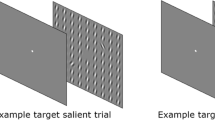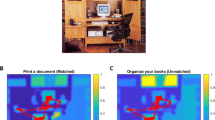Abstract
The Itti and Koch (Vision Research 40: 1489–1506, 2000) saliency map model has inspired a wealth of research testing the claim that bottom-up saliency determines the placement of eye fixations in natural scenes. Although saliency seems to correlate with (although not necessarily cause) fixation in free-viewing or encoding tasks, it has been suggested that visual saliency can be overridden in a search task, with saccades being planned on the basis of target features, rather than being captured by saliency. Here, we find that target regions of a scene that are salient according to this model are found quicker than control regions (Experiment 1). However, this does not seem to be altered by filtering features in the periphery using a gaze-contingent display (Experiment 2), and a deeper analysis of the eye movements made suggests that the saliency effect is instead due to the meaning of the scene regions. Experiment 3 supports this interpretation, showing that scene inversion reduces the saliency effect. These results suggest that saliency effects on search may have nothing to do with bottom-up saccade guidance.








Similar content being viewed by others
References
Buswell GT. How people look at pictures: a study of the psychology of perception in art. Chicago: University of Chicago Press; 1935.
Yarbus AL. Eye movements and vision. New York: Plenum; 1967.
Itti L, Koch C. A saliency-based search mechanism for overt and covert shifts of visual attention. Vis Res. 2000;40(10–12):1489–506.
Treisman A, Gelade G. A feature-integration theory of attention. Cogn Psychol. 1980;12:97–136.
Koch C, Ullman S. Shifts in selective visual attention: towards the underlying neural circuitry. Human Neurobiol. 1985;4:219–27.
Mannan S, Ruddock K, Wooding D. The relationship between the locations of spatial features and those of fixations made during visual examination of briefly presented images. Spat Vis. 1996;10(10):65–188.
Reinagel P, Zador AM. Natural scene statistics at the centre of gaze. Network-Computation In Neural Systems. 1999;10(4):341–50.
Tatler BW, Baddeley RJ, Gilchrist ID. Visual correlates of fixation selection: effects of scale and time. Vis Res. 2005;45(5):643–59.
Itti L, Koch C. Computational modelling of visual attention. Nat Rev Neurosci. 2001;2(3):194–203.
Parkhurst D, Law K, Niebur E. Modeling the role of salience in the allocation of overt visual attention. Vis Res. 2002;42(1):107–23.
Peters RJ, et al. Components of bottom-up gaze allocation in natural images. Vis Res. 2005;45(18):2397–416.
Henderson JM, et al. Visual saliency does not account for eye movements during visual search in real-world scenes. In: van Gompel R, et al., editors. Eye movements: a window on mind and brain. Amsterdam: Elsevier; 2007. p. 537–62.
Foulsham T, Underwood G. What can saliency models predict about eye movements?. Spatial and sequential aspects of fixations during encoding and recognition. J Vis. 2008;8(6):1–17.
Harding G, Bloj M. Real and predicted influence of image manipulations on eye movements during scene recognition. J Vis. 2010;10(2):8.1–17.
Underwood G, Foulsham T, Humphrey K. Saliency and scan patterns in the inspection of real-world scenes: eye movements during encoding and recognition. Vis Cogn. 2009;17(6–7):812–34.
Itti L. Quantifying the contribution of low-level saliency to human eye movements in dynamic scenes. Vis Cogn. 2005;12(6):1093–123.
Dorr M, Gegenfurtner KR, Barth E. The contribution of low-level features at the centre of gaze to saccade target selection. Vis Res. 2009;49(24):2918–26.
Underwood G. Cognitive processes in eye guidance: algorithms for attention in image processing. Cogn Comput. 2009;1:64–76.
Underwood G, et al. Eye movements during scene inspection: a test of the saliency map hypothesis. Eur J Cogn Psychol. 2006;18(3):321–42.
Foulsham T, Underwood G. How does the purpose of inspection influence the potency of visual saliency in scene perception? Perception. 2007;36:1123–38.
Henderson JM, Malcolm GL, Schandl C. Searching in the dark: cognitive relevance drives attention in real-world scenes. Psychon Bull Rev. 2009;16(5):850–6.
Chen X, Zelinsky GJ. Real-world visual search is dominated by top-down guidance. Vis Res. 2006;46(24):4118–33.
Foulsham T, Underwood G. Does conspicuity enhance distraction? Saliency and eye landing position when searching for objects. Quart J Exp Psychol. 2009;62(6):1088–98.
Navalpakkam V, Itti L. Modeling the influence of task on attention. Vis Res. 2005;45(2):205–31.
Torralba A, et al. Contextual guidance of eye movements and attention in real-world scenes: the role of global features in object search. Psychol Rev. 2006;113(4):766–86.
Cutsuridis V. A cognitive model of saliency, attention, and picture scanning. Cogn Comput. 2009;1:292–9.
McConkie GW, Rayner K. Span of effective stimulus during a fixation in reading. Percept Psychophys. 1975;17(6):578–86.
Rayner K. Eye movements in reading and information processing: 20 years of research. Psychol Bull. 1998;124(3):372–422.
Geisler WS, Perry JS, Najemnik J. Visual search: the role of peripheral information measured using gaze-contingent displays. J Vis. 2006;6(9):858–73.
Castelhano MS, Henderson JM. Initial scene representations facilitate eye movement guidance in visual search. J Exp Psychol Hum Percept Perform. 2007;33(4):753–63.
Loschky LC, McConkie GW. Investigating spatial vision and dynamic attentional selection using a gaze-contingent multiresolutional display. J Exp Psychol Appl. 2002;8(2):99–117.
Foulsham T, Teszka R, Kingstone A. Saccade control in natural images is shaped by the information visible at fixation: evidence from asymmetric gaze-contingent windows. Atten Percept Psychophys. (in press).
Valentine T. Upside-down faces—a review of the effect of inversion upon face recognition. Br J Psychol. 1988;79:471–91.
Gauthier I, Tarr MJ. Becoming a ‘‘greeble’’ expert: exploring mechanisms for face recognition. Vis Res. 1997;37(12):1673–82.
Husk JS, Bennett PJ, Sekuler AB. Inverting houses and textures: Investigating the characteristics of learned inversion effects. Vis Res. 2007;47(9):3350–9.
Kelley TA, Chun MM, Chua KP. Effects of scene inversion on change detection of targets matched for visual salience. J Vis. 2003;3(1):1–5.
Loftus GR, Mackworth NH. Cognitive determinants of fixation location during picture viewing. J Exp Psychol Hum Percept Perform. 1978;4(4):565–72.
Henderson JM, Weeks PA, Hollingworth A. The effects of semantic consistency on eye movements during complex scene viewing. J Exp Psychol Hum Percept Perform. 1999;25(1):210–28.
Underwood G, Foulsham T. Visual saliency and semantic incongruency influence eye movements when inspecting pictures. Quart J Exp Psychol. 2006;59(11):1931–49.
van Diepen PMJ, d’Ydewalle G. Early peripheral and foveal processing in fixations during scene perception. Visual Cognition. 2003;10(1):79–100.
Henderson JM. Eye-movement control during visual object processing—effects of initial fixation position and semantic constraint. Can J Exp Psychol. 1993;47(1):79–98.
Acknowledgments
TF is supported by a Commonwealth Fellowship from the Government of Canada. GJU was supported by project grant EP/E006329/1 from the EPSRC (UK). We are also grateful to Laurent Itti et al. for making the saliency map model available, and the comments of an anonymous reviewer.
Author information
Authors and Affiliations
Corresponding author
Rights and permissions
About this article
Cite this article
Foulsham, T., Underwood, G. If Visual Saliency Predicts Search, Then Why? Evidence from Normal and Gaze-Contingent Search Tasks in Natural Scenes. Cogn Comput 3, 48–63 (2011). https://doi.org/10.1007/s12559-010-9069-9
Received:
Accepted:
Published:
Issue Date:
DOI: https://doi.org/10.1007/s12559-010-9069-9




